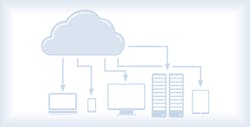Cloud computing and virtualization may be trending terms in the information technology world and piquing interest in the healthcare industry.
In fact, some in healthcare may use the terms “cloud” and “virtualization” interchangeably as if they represent complementary or similar functionality.
To rebuff any miscues, Health Management Technology sought out the expertise of more than a half-dozen IT executives to set the record straight for providers.
While the two terms are closely related, according to Chan Ghosh, Managing Director, Technology & Operation, Orion Health, they are indeed distinct ideas.
“Virtualization is a logical division of a dedicated resource like a CPU, hard drive or network, so that it can serve multiple applications and users,” Ghosh noted. “Because virtualization enables much more efficient use of hardware resources, it is a key enabler for efficient cloud computing. Cloud computing usually refers to leveraging remotely hosted versions of applications, so while cloud computing and virtualization go really well together, they are separate things that do not rely on each other to exist.”
For Jeremy Molnar, Vice President, Security Services, CynergisTek, the two represent different functions. Virtualization involves consolidation. “For example, you run multiple instances of servers off a single server or multiple desktop instances off a single server,” he said. Meanwhile, cloud computing involves distribution. “For example, saving data across multiple servers or running processes across multiple servers,” he added. “Cloud technologies are generally viewed as putting it on the Internet, but there are closed cloud environments as well. Keep in mind, cloud computing could be used to provide virtualization – see Platform as a Service (PaaS) or Desktop as a Service (DaaS) – as they are just distributing the virtualization services through the cloud.”
Calvin Hsu, Vice President, Product Marketing, Desktop and Apps, Citrix, emphasized how the two delineate virtual assets from physical assets.
“While there are multiple types of virtualization, at its core, virtualization is about creating virtual assets independent of the physical assets,” Hsu said. “You can have multiple virtual servers running on a single server, multiple virtual desktops or workspaces delivered to a mobile device or PC, or even virtual applications delivered to end-user devices. To deliver those virtual desktops, applications and workspaces, and to connect and operate those virtual servers, organizations use virtual networks and virtual storage assets.
“Cloud computing is fundamentally about buying IT as a service, and not needing to be concerned with knowing what or where the resources are,” he said. “Instead of purchasing, deploying and managing IT infrastructure, physical and virtual servers, and applications, organizations pay for computing, applications and workspace through a monthly service fee. Most cloud computing today depends on a wide range of virtual networks, storage, servers, etc., combined with automated operations, to deliver IT as a service.” Consequently, healthcare providers can obtain software and storage as a service and, increasingly, desktops, applications and mobile workspaces as a service, too.
Shared electronic services
Senior Vice President, Denodo Technologies
While virtualization and cloud computing may be different, the areas where they might overlap and share computing services provide at least incremental benefits, including amplifying some common advantages such as agility, lower cost and scalability, according to Suresh Chandrasekaran, Senior Vice President, Denodo Technologies.
“Virtualization refers to creating a virtual representation of a real or physical IT resource such as a computer server, storage, network, etc.,” Chandrasekaran said. “Server virtualization allows applications to use compute and memory resources allocated to them without regard to the underlying physical configurations. Data virtualization provides a virtual data view that abstracts and integrates one or more underlying real, physical data sources such as files, database records and SaaS applications containing fragmented customer data.”
Chandrasekaran likened virtualization to a personalized music playlist that points to specific mp3, wav and aac files stored on a laptop, a home media server or iCloud, communicating between virtual and physical resources.
Conversely, “cloud computing refers to deploying groups of hardware and software in a remote location that is accessed online as a utility, providing computing services or resources on demand,” he said. It can be classified as public, private or hybrid, depending on a variety of factors, including how resources are shared vs. dedicated, level of security, standardized capabilities and business models, he noted.
“Most cloud architectures use some form of hardware virtualization, but the distinct feature of cloud computing is online access,” Chandrasekaran added.
Virtualization involves running multiple workloads on a single physical system using shared resources, according to Doug Hazelman, Vice President, Product Strategy, Veeam Software. On the other hand, cloud computing spans different types, including private, public and hybrid versions. “In general, I feel cloud is a means of automated provisioning of applications and resources using a shared infrastructure,” he said. “A cloud can be built on top of virtualization, but virtualization is not required for cloud. It just makes the automation easier.”
But virtualization should not come as a surprise to healthcare IT leaders as it really isn’t a new concept, according to Chris Schremser, Chief Technology Officer, ZirMed.
“Virtualization has been around a long time – at least compared to cloud computing as we think of it today – so it’s also fair to say that virtualization is a more mature technology and market,” he observed. “Virtualization is based on the idea of a logical partition. It’s a way to virtually separate the capacity and computing resources of a single piece of physical hardware like a server, which enables you to get more out of that hardware by segmenting off excess capacity that would otherwise go to waste.
“Almost without exception, there are times of day or days of the week when demand peaks [as in] when more people are using the application,” Schremser continued. “You have to be able to accommodate those peaks, and virtualization allows you to do that without having as many solely dedicated physical resources.” He further indicated that ZirMed’s servers currently are 90 percent virtualized and will be completely virtualized by year’s end.
Power tooling up
Virtualization is part of the IT toolset, noted Henri “Rik” Primo, Director, Strategic Relationships, SYNGO, Siemens Healthcare. “Rather than running applications on dedicated servers in different departments, the applications such as billing, EMR, PACS, email, registration, ordering, etc., now run on a cluster of servers located in the healthcare provider’s data center,” he said. “These servers are interlinked by virtualization software and create a common pool of computing and storage resources. The virtualization software will dynamically assign the applications to the required hardware resources in the virtualized environment.”
Virtualization is often the required IT tool to enable a cloud computing environment, Primo noted. “The end-user interaction with the application servers can be achieved with so-called ‘thin client’ software that typically runs in a Web browser. This minimizes the requirement to install the applications on dedicated workstations, also called ‘fat clients.’ Maintaining and updating application software in the data center is much more cost effective compared to maintaining and updating the software on each workstation separately.”
David Ting, Chief Technology Officer and Founder, Imprivata, distinguished virtualization and cloud computing as different approaches for delivering applications and information to users.
“Desktop virtualization moves applications and information from computing endpoints, such as desktops, laptops, etc., onto centralized servers that can each service multiple users,” Ting said. “End users access their personal desktop and applications using Citrix or VMware as the hosting environment and a thin- or zero-client endpoint device that manages presentation services. This gives providers roaming access to clinical applications and patient information at the point of care while also improving security and supporting HIPAA compliance by keeping protected health information (PHI) in a secure, centralized server rather than distributed on PCs, laptops, tablets and smartphones throughout the hospital.”
Meanwhile, cloud computing moves the hosting server used to deliver desktops or applications to a cloud computing vendor that can service users from different organizations via software or Web-based applications, he added.









